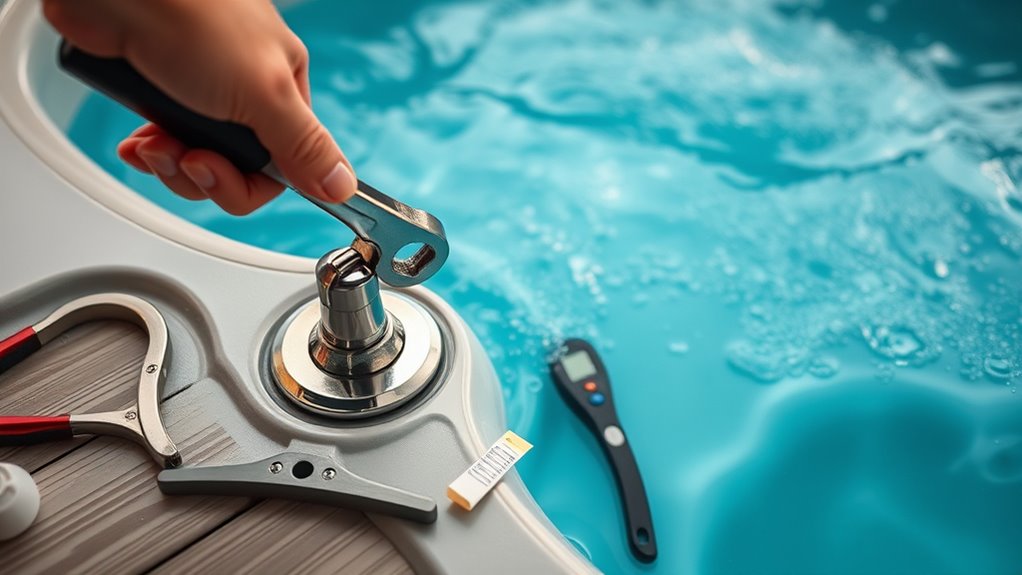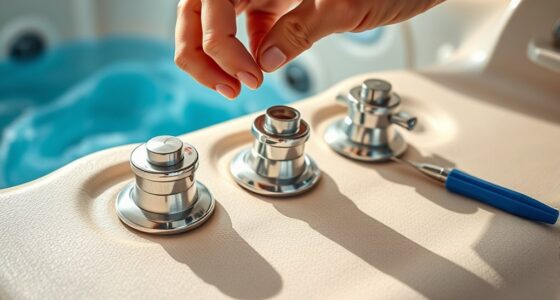To keep your hot tub in top shape, regularly check and balance the water chemistry, including pH, alkalinity, and sanitizer levels. Clean and replace filters every few weeks, drain and refill the water when needed, and maintain the cover and shell to prevent damage. Managing algae and bacteria with proper sanitization guarantees safe water. For detailed tips on each step, staying on top of maintenance will help you enjoy your hot tub longer.
Key Takeaways
- Regularly test and balance water chemistry, including pH, alkalinity, and sanitizer levels, to ensure safe and clear water.
- Maintain filters by cleaning every 4–6 weeks and replacing them every 1–2 years to ensure optimal water circulation.
- Drain and refill the hot tub periodically, then balance the water chemistry before use.
- Clean the cover and shell surface regularly to prevent stains, UV damage, and buildup.
- Control algae and bacteria by maintaining sanitizer levels, shocking weekly, and ensuring proper water circulation.
Understanding Hot Tub Water Chemistry
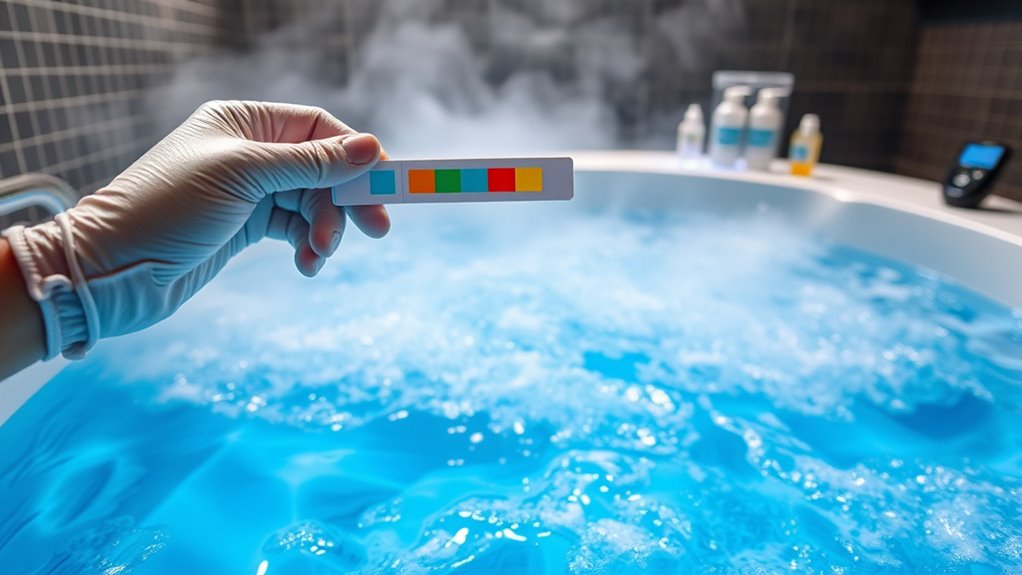
Understanding hot tub water chemistry is essential for maintaining a safe and enjoyable soak. When you keep the right balance of chemicals, you prevent bacteria growth, clear cloudy water, and protect your equipment. The main components to monitor are pH, alkalinity, and sanitizer levels. A proper pH level, typically between 7.2 and 7.8, ensures comfort and prevents corrosion or scaling. Alkalinity acts as a buffer, stabilizing pH fluctuations. Sanitizers like chlorine or bromine eliminate harmful bacteria and algae. If these levels are off, water can become unsafe or unpleasant. Regularly checking and adjusting these chemistry levels keeps your hot tub clean, safe, and inviting. Understanding these basics empowers you to maintain a healthy, sparkling hot tub environment. Proper water chemistry also helps reduce equipment damage and prolongs the lifespan of your hot tub components. Using a reliable water testing kit allows for more accurate measurements and better maintenance decisions. Incorporating home security systems to monitor your hot tub area can also prevent unauthorized access and ensure safety. Additionally, maintaining correct chemical levels minimizes skin irritation and ensures a comfortable soak. Being aware of water chemistry principles helps you troubleshoot issues more effectively and maintain optimal water quality.
Regular Water Testing and Balancing
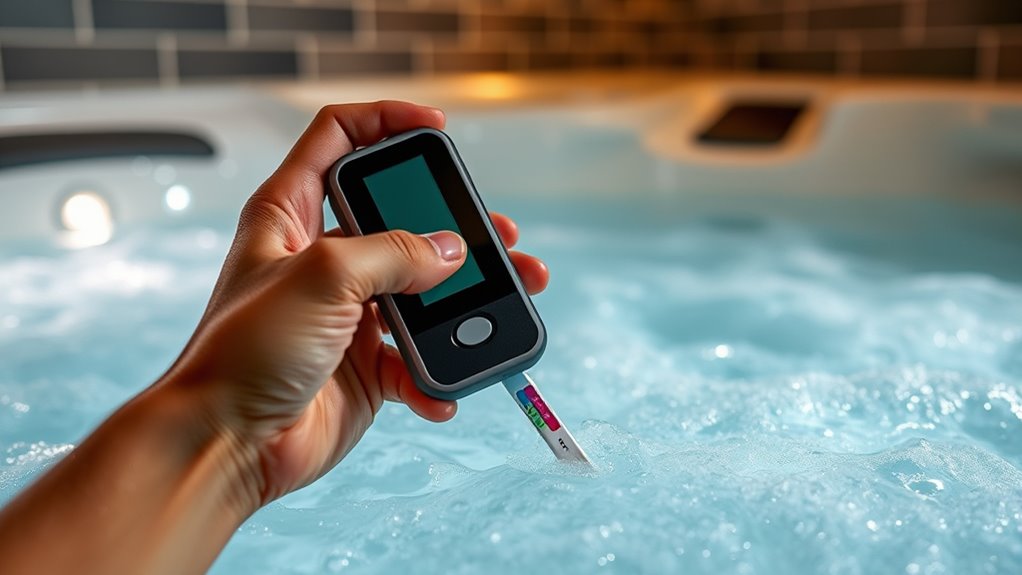
Regular water testing is the foundation of effective hot tub maintenance because it helps you catch imbalances before they become serious issues. By testing your water regularly, you guarantee that pH, alkalinity, and sanitizer levels stay within ideal ranges. Use test strips or a liquid test kit to measure these parameters, ideally at least once a week. If your pH is too high or low, it can cause skin irritation and reduce sanitizer effectiveness. Low alkalinity can lead to fluctuating pH levels, making balancing more difficult. Keep detailed records of your test results to identify patterns and maintain consistent water quality. Proper testing allows you to make informed adjustments, creating a safe, clean, and comfortable soak every time. Incorporating automated testing systems can further enhance accuracy and save time in your maintenance routine. Additionally, regular testing helps prevent the buildup of scale and biofilm, which can compromise water clarity and equipment function. Staying aware of innovative water treatment methods can also improve your overall hot tub care. Regular testing also enables you to better understand state-specific water chemistry requirements, ensuring optimal conditions tailored to your location.
Adding and Adjusting Chemicals

Adding and adjusting chemicals is essential for maintaining balanced and safe hot tub water. You want to keep the water properly sanitized to prevent bacteria growth and cloudy water. Start by testing your water regularly with test strips or a testing kit. If the sanitizer level is low, add the appropriate amount of sanitizer, such as chlorine or bromine, following the manufacturer’s instructions. If pH levels are off, you’ll need to add pH increaser or decreaser to bring the levels into the recommended range of 7.2 to 7.8. Always add chemicals slowly and in small amounts, then retest before adding more. Proper chemical adjustments keep your hot tub water clean, safe, and comfortable for soaking. Regular maintenance and understanding water chemistry are crucial for optimal hot tub performance. Using calibrated test equipment ensures more accurate readings and better chemical balancing. Maintaining proper water quality helps extend the lifespan of your hot tub components and enhances your overall soaking experience. Additionally, understanding vetted products and techniques can help you choose the most effective chemicals and tools for safe and efficient hot tub care. Being aware of industry trends can also guide you in selecting the latest and most effective maintenance products.
Cleaning and Replacing Filters

Regularly cleaning your filters keeps your hot tub water clear and prevents buildup. You should also follow a consistent replacement schedule to guarantee ideal performance. Let’s explore effective cleaning techniques and tips for knowing when to replace your filters. Staying aware of filter vulnerabilities can help you maintain optimal safety and efficiency in your hot tub maintenance. Additionally, understanding the importance of proper filtration can extend the lifespan of your hot tub components and improve water quality. Regular inspection of your filters can help identify wear and tear, ensuring timely replacements and maintaining overall system health. Being mindful of air quality in your environment can further enhance the effectiveness of your filtration system and overall water clarity. Recognizing trust issues within your relationship can also inform how you approach maintenance and care routines, ensuring a more harmonious environment.
Subheading 1: Filter Cleaning Techniques
Cleaning your hot tub filter is essential for maintaining ideal water circulation and ensuring a clean, safe soak. To do this effectively, start by turning off your hot tub and removing the filter. Rinse it under running water to wash away loose debris. For a deeper clean, soak the filter in a solution of filter cleaner or a mixture of water and vinegar for 15-30 minutes. Use a soft brush to scrub away any remaining dirt or oils, paying close attention to pleats. Rinse thoroughly before reinstalling. Regular cleaning prevents buildup that can hinder filtration, reduce water quality, and strain your pump. Aim to clean your filter at least once every 4-6 weeks, especially during heavy use or if you notice reduced water clarity.
Subheading 2: Replacement Schedule Tips
Maintaining a proper filter replacement schedule guarantees your hot tub stays clean and runs efficiently. You should replace your filters every 1 to 2 years, depending on usage and water quality. Check the manufacturer’s guidelines for specific recommendations. Regularly inspect your filters for signs of wear, such as tears, excessive dirt, or loss of shape. Even if they look okay, replacing them on schedule ensures peak filtration. Keep a log of when you replace filters to stay consistent. If you notice cloudy water, lingering odors, or reduced jet performance, it’s a sign it’s time for a new filter. Proper scheduling prevents buildup of debris and bacteria, saving you time and money on more extensive cleaning or repairs later. Incorporating self-watering plant pots into your routine can help maintain consistent moisture levels, reducing the risk of over- or under-watering your plants, which is similar to maintaining filter effectiveness in your hot tub.
Draining and Refilling Your Hot Tub
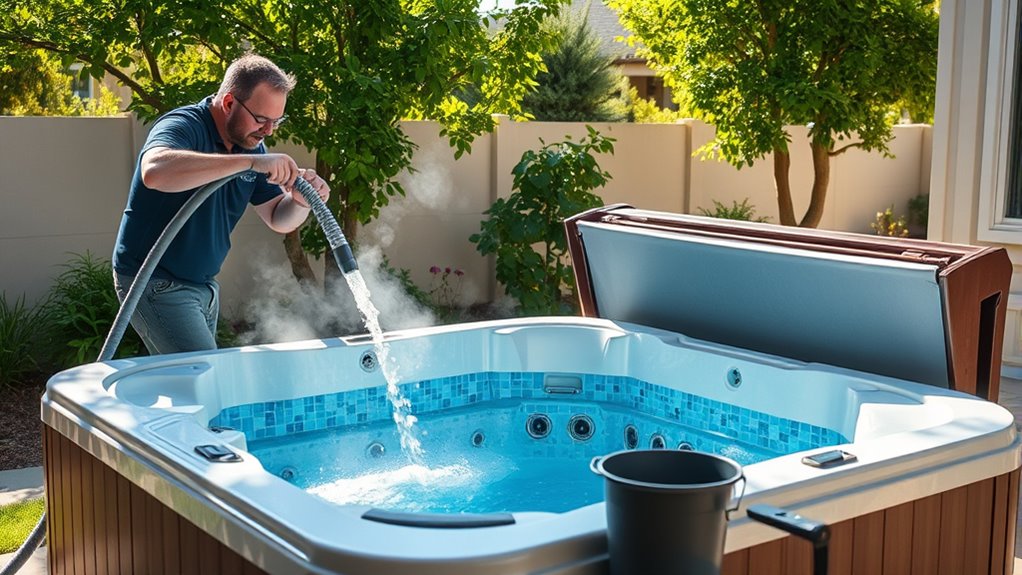
Knowing when to drain your hot tub is essential to keep the water clean and safe. Using proper draining techniques guarantees you avoid damage and make the process easier. Once drained, you’ll need to refill and balance the water to keep your hot tub comfortable and functioning correctly.
When to Drain Hot Tub
You should drain your hot tub when the water becomes cloudy, develops an off-putting smell, or shows signs of buildup that regular balancing can’t fix. If you notice skin irritation or the water no longer responds to sanitizers, it’s time for a drain. Here’s a quick overview:
| Issue | Typical Cause | When to Drain |
|---|---|---|
| Cloudy water | Bacteria or mineral buildup | When persistent |
| Foul smell | Bacterial contamination | When odor persists |
| Buildup on surfaces | Mineral deposits, scum | When cleaning no longer helps |
| Skin irritation | Contaminants, bacteria | When symptoms appear |
Regular draining keeps your hot tub safe, clean, and enjoyable.
Proper Draining Techniques
Before draining your hot tub, gather all necessary supplies such as a submersible pump, a hose, and cleaning tools. Turn off the power to guarantee safety. Attach the pump to a power source and submerge it in the hot tub, then turn it on to start draining. Position the hose outlet in a suitable drainage area to avoid water damage. As the water begins to flow out, monitor the process to prevent over-draining or spills. Once the tub is empty, remove the pump and clean any residual debris or buildup inside the shell. Check for any leaks or damage to the drain valve or plumbing. Properly disposing of the drained water and cleaning the tub thoroughly will prepare it for the next steps.
Refilling and Balancing Water
After ensuring the hot tub is completely drained and cleaned, it’s time to refill it with fresh water. Begin by closing any valves or drain plugs, then fill the tub using a garden hose or a dedicated fill valve. As the water level rises, monitor it to prevent overfilling. Once filled to the recommended level, turn on the jets to circulate the water. Next, test the water’s pH, alkalinity, and sanitizer levels using test strips or a kit. Adjust these parameters with pH increasers or decreasers, alkalinity boosters, and sanitizer as needed. Proper balancing guarantees water stays clear, safe, and comfortable. Regularly check levels, especially after refilling, to maintain ideal water chemistry and prevent issues like scaling or corrosion.
Maintaining the Hot Tub Cover and Shell

Maintaining the hot tub cover and shell is essential for keeping your spa in top condition. Regular upkeep prevents damage, preserves appearance, and extends the life of your equipment. To care for your cover, clean it with a mild detergent and water, avoiding harsh chemicals. Protect it from UV rays by using a cover protector or keeping it shaded when not in use. For the shell, wipe down surfaces with a soft cloth and non-abrasive cleaner to remove dirt and prevent staining. Additionally, inspect the cover’s hinges and straps for wear, and replace them if necessary.
- Clean with gentle, non-abrasive products
- Use a cover protector to block UV rays
- Regularly inspect hinges and straps
- Wipe down the shell to prevent buildup
Managing Algae and Bacterial Growth

Algae and bacteria can quickly proliferate in your hot tub if not properly managed, leading to cloudy water, unpleasant odors, and potential health risks. To prevent this, regularly test your water’s chemical levels, especially sanitizer and pH. Maintain sanitizer levels within the recommended range to kill germs effectively. Shock your hot tub weekly with a sanitizer boost to eliminate organic contaminants. Keep the water circulating with the pump to prevent stagnant areas where algae can thrive. Also, shower before entering to reduce organic matter introduced into the water. If you notice algae growth or cloudy water, raise sanitizer levels and brush the surfaces thoroughly. Consistent maintenance and proper chemical balance are key to keeping algae and bacteria at bay, ensuring a safe and enjoyable hot tub experience.
Troubleshooting Common Maintenance Issues
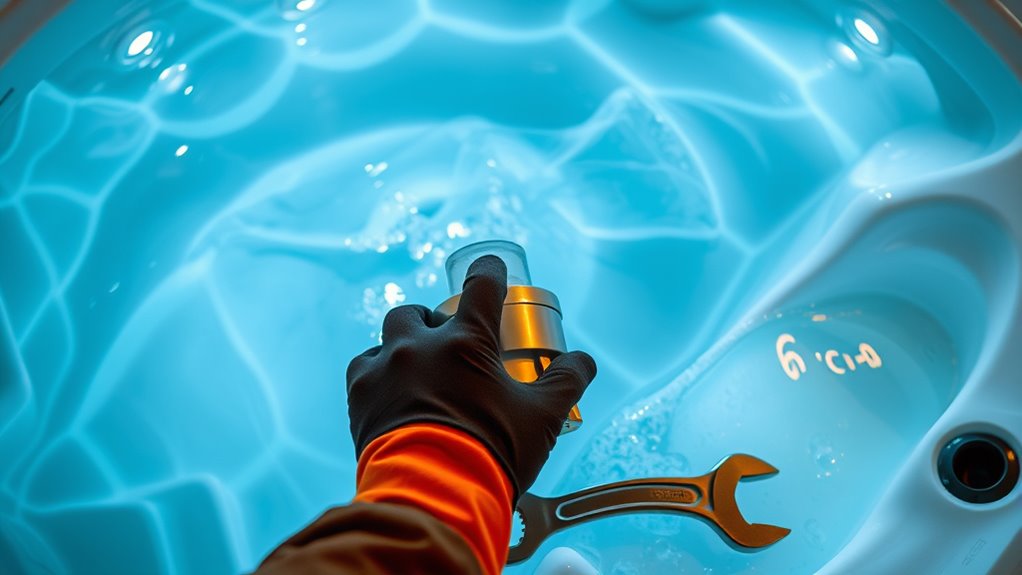
Troubleshooting common maintenance issues is essential for keeping your hot tub in ideal condition. When problems arise, quick identification helps prevent further damage and costly repairs. Start by inspecting the water quality; cloudy water may indicate filtration issues or imbalanced chemicals. Listen for unusual noises, which could signal a pump or motor malfunction. Check for leaks around fittings or hoses, as these can lead to water loss and equipment damage. Also, examine the jets—clogged or weak jets often mean blockages or pump issues.
Regularly check water quality, listen for noises, and inspect for leaks to prevent costly hot tub repairs.
To troubleshoot effectively, consider these steps:
- Verify that water chemistry is balanced and pH levels are correct
- Clean or replace filters regularly to maintain proper flow
- Inspect and tighten fittings or hoses for leaks
- Ensure the pump and heater are functioning properly
Seasonal Maintenance and Long-Term Care
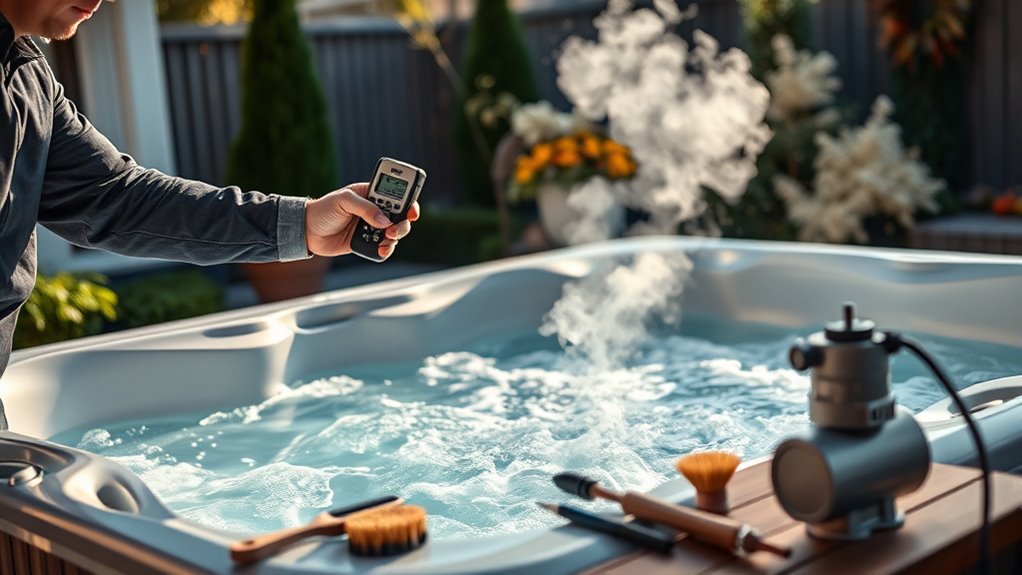
Seasonal maintenance and long-term care are essential for keeping your hot tub in peak condition year-round. During colder months, you should regularly check the water chemistry and keep the cover secure to prevent heat loss and debris entry. Consider draining and deep cleaning your hot tub at least once a year to remove buildup and guarantee ideal performance. In warmer months, focus on maintaining proper chemical balance and cleaning filters to prevent algae growth. If you won’t use your hot tub for an extended period, drain the water, clean the shell, and store the cover in a dry place. Regular inspections of pumps, jets, and electrical components will help catch potential issues early, extending your hot tub’s lifespan and ensuring it’s always ready when you want to relax.
Frequently Asked Questions
How Often Should I Completely Drain and Refill My Hot Tub?
You should drain and refill your hot tub every 3 to 4 months to keep the water fresh and prevent buildup of minerals and bacteria. If you use it frequently or notice cloudy water, you might need to do it more often. Regular draining helps maintain water quality and extends the life of your hot tub. Always follow your manufacturer’s recommendations for specific maintenance routines.
What Are the Signs of a Failing Hot Tub Pump?
Imagine your hot tub’s soothing warmth suddenly turns into a frustrating noise or weak jets. You notice strange sounds, inconsistent water flow, or a sudden increase in your energy bill. These signs point to a failing pump. You might also see leaks or the pump failing to start. Keep an eye on these clues, because catching problems early saves you money and keeps your hot tub relaxing.
Can I Use Household Cleaning Products on My Hot Tub?
You might be tempted to use household cleaning products on your hot tub, but it’s not a good idea. These cleaners often contain chemicals that can damage the acrylic surface, clog filters, or harm the plumbing. Instead, stick to products specifically designed for hot tubs, and follow the manufacturer’s cleaning instructions. This way, you’ll keep your hot tub clean, safe, and functioning properly without risking costly damage.
How Do I Prevent Cold Weather Damage to My Hot Tub?
To prevent cold weather damage, you should regularly check your hot tub’s water level and maintain proper chemical balance. Cover it with a sturdy, insulated cover to keep heat in and debris out. If you’re leaving it unused for an extended period, consider draining the water completely or using a freeze protection system. These steps help avoid freezing pipes and equipment damage, ensuring your hot tub stays in great shape year-round.
What Safety Precautions Should I Take During Maintenance?
Think of safety precautions like a knight preparing for battle—you need to gear up properly. Always turn off the power before working on your hot tub, wear protective gloves and goggles, and make certain proper ventilation if you’re using chemicals. Keep a fire extinguisher nearby and avoid working alone. By following these steps, you protect yourself and ensure your maintenance session is safe and successful, just like a hero ready for any challenge.
Conclusion
Keeping your hot tub pristine is like tending a delicate garden—you nurture it with care, patience, and attention to detail. When you stay on top of water chemistry, filters, and seasonal upkeep, you create a haven of relaxation that sparkles like a summer star. Your effort transforms your hot tub into a bubbling oasis, a sanctuary where worries melt away. With each maintenance task, you craft a warm, inviting retreat that’s all yours to enjoy.
